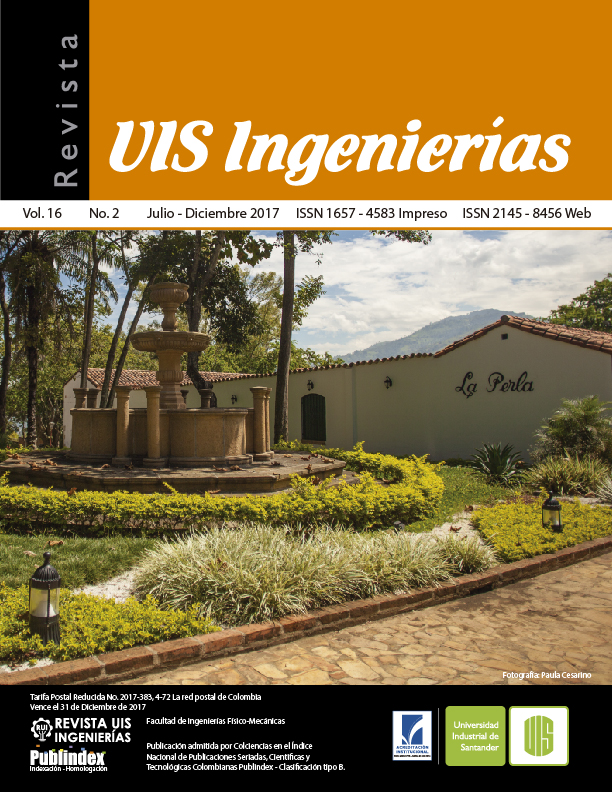Characterization of ceramics, immersed in solutions of the system sio2 - tio2 - zro2 synthesized by the sol-gel method
Published 2017-05-30
Keywords
- Red clay,
- mechanical resistance to flexion,
- SiO2 – TiO2 – ZrO2 system,
- ceramic,
- sol-gel
How to Cite
Abstract
The results of structural, microchemical and physicoceramic characterization of ceramic samples (red clay) immersed in solutions "TiO2 - ZrO2- SiO2" is presented. Samples were prepared by the sol-gel method using tetraethyl ortosilicate, titanium tetrabutoxide and zirconium tetrabutoxide. Ceramics samples for immersion were prepared with atomized powders of red clay and subjected to firing at 1000 °C. The samples were made from ceramic powders atomized red clay, fired at 1000 °C. After firing ceramics were immersed in the solutions in volume concentrations 10/20/70: Si /Ti /Zr and 10/70/20: Si/Ti /Zr. Immersion times were 2, 4 and 6 minutes respectively. Subsequent to drying the samples were subjected to firing at 600 °C for 1 hour, at a rate of 2 °C/min. Microchemical and microstructural aspects of the fired samples were established using X-ray diffraction (XRD), infrared spectroscopy (FTIR) and x-ray dispersive energy (EDX). Technological properties evaluated were water absorption, bulk density and mechanical resistance to flexion. The study results allowed to determine that mechanical resistance to flexion improvement in samples immersed in the solution 10/70/20: Si/Ti/Zr. Similarly, a slight reduction in the percentage of water absorption with this same treatment was observed. Treatment with greater amount of zirconium, shows no significant changes in relation to the standard used.
Downloads
References
- J. Sánchez., “Estrategias para la competitividad del Clúster de la cerámica del área metropolitana de Cúcuta”, Tesis de Maestría, Universidad Nacional experimental del Táchira, San Cristóbal – Venezuela, 2010
- P. Ramirez P., “Planteamiento Estratégico para el Desarrollo de la Innovación Tecnológica en el Sector Cerámico del área metropolitana de Cúcuta”. Tesis de Maestría, Universidad Nacional experimental del Táchira, San Cristóbal – Venezuela, 2010
- Qubit cluster technology based consortium, “Estrategia para la conformación del Clúster y plan estratégico para la cadena de cerámica en Cúcuta”, Segundo informe, Cúcuta, 2007
- I. Nuñez et al., “Investigaciones de interés industrial sobre baldosas cerámicas”, [Online] Técnica Industrial, pp 26, 2004, Disponible en: http://www.tecnicaindustrial.es/tiadmin/numeros/11/38/a38.pdf
- M. Castro, “Recubrimientos protectores obtenidos por deposición electroforética EPD a partir de suspensiones Sol-gel” Tesis de Doctorado en Química, Instituto de Cerámica y Vidrio (CSIC), Madrid, 2003
- . M. Salvador, “Recubrimientos cerámicos obtenidos mediante proyección térmica por plasma atmosférico a partir de polvos reconstituidos NANOESTRUCTURADO” [Online], III Congreso Nacional de Pulvimetalurgia, Valencia, 2010, Recuperado de: http://digital.csic.es/handle/10261/42686
- S. Mollazadeh S, et al., “The role of TiO2, ZrO2, BaO and SiO2 on the mechanical properties and crystallization behavior of fluorapatite–mullite glass–ceramics”, Journal of Non-CrystallineSolids Volume 361, 1, pp 70, 2013
- S. Dudczig et al., “Nano- and micrometre additions of SiO2, ZrO2 and TiO2 in fine grained alumina refractory ceramics for improved thermal shock performance”, Ceramics International, Volume 38, Issue 3, 2012
- T. Ebadzadeh, E. Ghasemi, “Effect of TiO2 addition on the stability of t-ZrO2 in mullite–ZrO2 composites prepared from various starting materials”. Ceramics International, Volume 28, Issue 4, 447–450, 2002
- E. Rambaldi et al., “Nano-oxides to improve the surface properties of ceramic tiles”. Boletín de la Sociedad Española de Cerámica y Vidrio. V. 49, 4, 253-258, 2010
- J. Bautista et al., “Multi-capas cerámicas SiO2-TiO2-ZrO2 sintetizadas por el método sol-gel para aplicaciones anticorrosivas”, Revista Colombiana de física, Vol. 38, No. 4, 1455-1463, 2006
- . S. Young et al. “Fabrication and characterization of zirconium carbide (ZrC) nanofibers with termal storage property”. Thin solid films. Volume 517, issue 24, 6531–6538, 2009
- J. Bautista, J. Sandoval and C. Ortiz, “ Characterizations of coatings obtained by dip coating from sol-gel suspensions”. Revista mexicana de física , 55 (1), 144–147, 2009
- J. Bautista, C. Ortiz, E. Vera, “Influencia del tipo de sinterizado en el comportamiento anticorrosivo de recubrimientos”, Revista Respuestas, 13(2), 5-10, 2008
- J. Bautista, “Producción y caracterización de placas cerámicas SiO2 - TiO2 - ZrO2 sintetizadas por el método Sol gel para aplicaciones anticorrosivas”, Tesis de Maestría, UPTC, Colombia, 2010
- Instituto Colombiano de Normas Técnicas y Certificación, NTC 4321-4. (2005). Baldosas cerámicas .parte 4. Método de ensayo para determinar el módulo de rotura y la resistencia a la flexión. Bogotá D.C. ICONTEC.
- Instituto Colombiano de Normas Técnicas y Certificación, Baldosas cerámicas .parte 3. Método de ensayo para determinar la absorción de agua, porosidad aparente, densidad relativa aparente y densidad aparente., NTC 4321-3, 2005
- W. Smykatz., Differential thermal analysis, application and results in mineralogy, Berlin:Springer-Verlag, 1974

